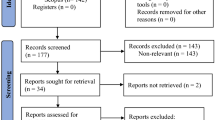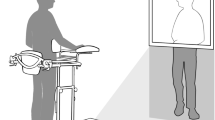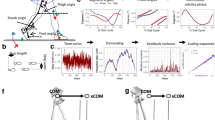Abstract
Study design
Single-subject repeated measures study.
Objectives
Neuromuscular electrical stimulation (NMES) can enhance walking for people with partial paralysis from incomplete spinal cord injury (iSCI). This single-subject study documents an individual’s experience who both received an experimental implanted NMES system and underwent clinical bilateral hinged total knee arthroplasty (TKA). She walked in the community with knee pain prior to either intervention. Walking performance improved with an implanted NMES system. Knee pain and instability continued to worsen over time and eventually required TKA. This study evaluates the effects of these interventions.
Setting
Louis Stokes Cleveland Veterans Affairs Medical Center, Cleveland OH, USA.
Methods
The differential and combined effects of NMES and hinged knee replacement were assessed in terms of walking speed, toe clearance, knee angle, and participant perceptions with and without stimulation assistance both before and after TKA.
Results
The combined approach both reduced pain and restored walking ability to levels achieved prior to developing significant knee pain that prevented walking without NMES. There was an interaction effect between NMES and TKA on walking speed. Toe clearance consistently improved with stimulation assistance and TKA prevented significant knee hyperextension. The greatest impact was on endurance. Knee replacement re-enabled long distance walking with the addition of stimulation again more than doubling her maximum walking distance from 214 to 513 m.
Conclusions
These data support further research of combined implantable interventions that may benefit people with iSCI. Furthermore, joint laxity and pain may not necessarily be contraindications to NMES if addressed with conventional clinical treatments.
Similar content being viewed by others
Log in or create a free account to read this content
Gain free access to this article, as well as selected content from this journal and more on nature.com
or
Data availability
The datasets generated and analyzed during the current study are available from the corresponding author on reasonable request.
References
National Spinal Cord Injury Statistical Center, Facts and Figures at a Glance. Birmingham, AL: University of Alabama at Birmingham, 2020.
Agarwal S, Kobetic R, Nandurkar S, Marsolais EB. Functional electrical stimulation for walking in paraplegia: 17-year follow-up of 2 cases. J Spinal Cord Med. 2003;26:86–91.
Dutta A, Kobetic R, Triolo RJ. Ambulation after incomplete spinal cord injury with EMG-triggered functional electrical stimulation. IEEE Trans Biomed Eng. 2008;55:791–4.
Hardin E, Kobetic R, Murray L, Corado-Ahmed M, Pinault G, Sakai J, et al. Walking after incomplete spinal cord injury using an implanted FES system: a case report. J Rehabil Res Dev. 2007;44:333–46.
Kobetic R, Triolo RJ, Uhlir JP, Bieri C, Wibowo M, Polando G, et al. Implanted functional electrical stimulation system for mobility in paraplegia: a follow-up case report. IEEE Trans Rehabil Eng. 1999;7:390–8.
Koubaa S, Ksibi I, Lebib S, Tlili L, Ben Salah FZ, Dziri C, et al. Total knee arthroplasty in a spinal cord-injured patient: a case report. Ann Phys Rehabil Med. 2009;52:588–93.
Zietek P, Dobiecki K. Total knee arthroplasty in patient with paraplegia after spinal cord injury. Acta Chir Orthop Traumatol Cechoslov. 2015;82:84–8.
Lombardo LM, Kobetic R, Pinault G, Foglyano KM, Bailey SN, Selkirk S, et al. Impact of an implanted neuroprosthesis on community ambulation in incomplete SCI. J Spinal Cord Med. 2018;41:165–73.
Smith B, Peckham PH, Keith MW, Roscoe DD. An externally powered, multichannel, implantable stimulator for versatile control of paralyzed muscle. IEEE Trans Biomed Eng. 1987;34:499–508.
Memberg WD, Peckham H, Keith MW. A surgically-implanted intramuscular electrode for an implantable neuromuscular stimulation system. IEEE Trans Rehabil Eng. 1994;2:80–91.
Foglyano KM, Schnellenberger JR, Kobetic R, Lombardo L, Pinault G, Selkirk S, et al. Accelerometer-based step initiation control for gait-assist neuroprostheses. J Rehabil Res Dev. 2016;53:919–32.
Pasquier G, Ehlinger M, Mainard D. The role of rotating hinge implants in revision total knee arthroplasty. EFORT Open Rev. 2019;4:269–78.
Kadaba MP, Ramakrishnan HK, Wootten ME. Measurement of lower extremity kinematics during level walking. J Orthop Res. 1990;8:383–92.
Middleton A, Fulk GD, Beets MW, Herter TM, Fritz SL. Self-selected walking speed is predictive of daily ambulatory activity in older adults. J Aging Phys Act. 2016;24:214–22.
Delianides C, Tyler D, Pinault G, Ansari R, Triolo R. Implanted high density cuff electrodes functionally activate human tibial and peroneal motor units without chronic detriment to peripheral nerve health. Neuromodulation. 2020;23:754–62.
Kilgore KL, Hoyen HA, Bryden AM, Hart RL, Keith MW, Peckham PH. An implanted upper-extremity neuroprosthesis using myoelectric control. J Hand Surg Am. 2008;33:539–50.
Vasso M, Beaufils P, Schiavone Panni A. Constraint choice in revision knee arthroplasty. Int Orthop. 2013;37:1279–84.
Acknowledgements
The authors would like to thank Jennifer Kerbo for creating Fig. 1 and editing the videos.
Funding
This work was supported by R01NS040547 and KL2TR002547 from the National Institutes of Health as well as 2 I50 RX001871-06, B7692R, and Dr. Triolo’s Paul B. Magnusson award from the United States Department of Veterans Affairs Rehabilitation Research and Development Service.
Author information
Authors and Affiliations
Corresponding author
Ethics declarations
Conflict of interest
The authors declare that they have no conflict of interest.
Additional information
Publisher’s note Springer Nature remains neutral with regard to jurisdictional claims in published maps and institutional affiliations.
Rights and permissions
About this article
Cite this article
Makowski, N.S., Lombardo, L.M., Foglyano, K.M. et al. Walking after incomplete spinal cord injury with an implanted neuromuscular electrical stimulation system and a hinged knee replacement: a single-subject study. Spinal Cord Ser Cases 6, 86 (2020). https://doi.org/10.1038/s41394-020-00336-8
Received:
Revised:
Accepted:
Published:
DOI: https://doi.org/10.1038/s41394-020-00336-8



